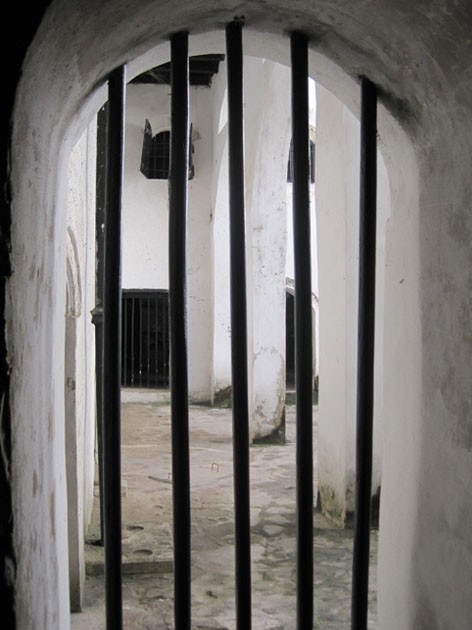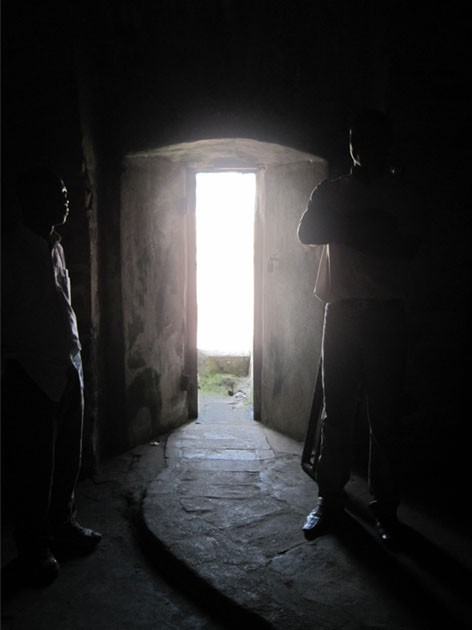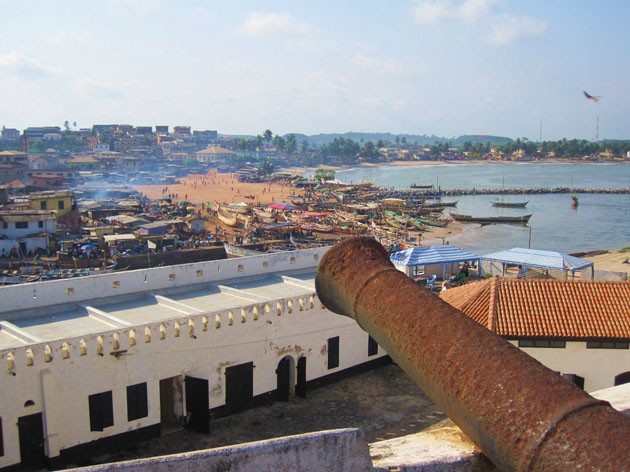 Claire Chaffey writes: There’s something menacing about the way the Atlantic crashes against the bleak Ghanaian coastline, and despite the stifling heat, I shiver.
Claire Chaffey writes: There’s something menacing about the way the Atlantic crashes against the bleak Ghanaian coastline, and despite the stifling heat, I shiver.
As my taxi hurtles at break-neck speed along the palm-strewn shore, with sporadic piles of smouldering rubbish acting as smoky beacons, I spy the harbour town of Elmina beckoning in the distance.
Rows of mud huts line either side of the pot-holed road, blurring into one long string of dwellings as the warm wind rushes through the taxi’s open windows and the tantalising aroma of smoked fish invades the battered old car.
Beneath the heavy, angry clouds of the wet season we draw nearer to the town centre, and I can just make out the figures of local fishermen pulling their brightly painted pirogues onto the shore, laden with the morning’s catch. Others quietly mend their nets amidst the hustle and bustle of the fish markets. Daily life plays out like a simple — yet idyllic — existence on the sand.
Above it all — looming and omnipresent — sits a white-washed castle, seemingly casting a watchful eye over its people. It is this that I have come to see: the guardian of a dark and tragic story which has marked this village, and the nation, forever.
The fishing village of Elmina, which lies on Ghana’s Gold Coast in Central Region, was the first pocket of West Africa to be settled by Europeans.
When the Portuguese moored here in the late 15th century, they sought fortune in the form of gold and ivory. When they happened upon Elmina’s protected harbour, they were gifted with the perfect location to build Castle Sao Jorge da Mina (now known as St George’s Castle). Soon, though, exploitation of gold took a back seat to what seemed like an endless supply of an equally valuable commodity: slaves.
In 1627 the Dutch captured the castle and, in the late 19th century, it eventually fell into the hands of the British.
When I reach the castle, its languid beauty is almost breathtaking. Peeling whitewashed walls, topped with chipped terracotta tiles, have retained an distinct air of magnificence.
Crossing the lowered drawbridge, I’m just in time to join a small group of visitors who have been allocated a local guide. Charles is a tall, proud-looking man with a gregarious and animated demeanour.
Trailing behind him, we wander into the castle’s courtyard. It’s bright and sunny and exotic, but the mood is about to change: we are soon to discover that the most sordid parts of this castle are very, very dark.
As we marvel at the withering beauty of the rustic interior, Charles leads us into one of the many holding cells occupying the courtyard. A damp smell immediately descends as our eyes adjust to the darkness.

The view from inside one of the holding cells
“If you spend a few minutes in here, you will perhaps better appreciate the amount of air and light within,” says Charles in his deep, velvety West African lilt.
Leaving us, he locks the door and wanders back into the courtyard.
Peering through the iron bars which stand between us and fresh air, it suddenly becomes much easier to imagine what went on here.
“Over the course of around 200 years it is estimated that more than 200 million West Africans were captured, imprisoned and shipped out to various colonies in the Americas,” explains Charles from the courtyard.
“The vast majority never returned to these shores. Generations of families were stolen and sold, like cattle, and those who survived the treacherous journey across the Atlantic were doomed to spend their lives as slaves to a foreign master in a foreign land.”
The group has fallen silent as Charles unlocks the door to the suffocating cell. We cross the courtyard in sober reflection. Next, he shows us a church in which the castle’s occupiers worshipped and prayed.
“This church happens to be built on top of some of the cells, where hundreds of slaves were kept at any given time, wallowing in their own filth and misery,” says Charles bluntly.
We also see the balcony from which the castle’s Governor gazed down upon the captive women. “He used to carefully select a woman who pleased him enough to be sent to him, via a private trap-door, later that night,” recounts Charles.
The group has gone remarkably quiet, burdened by the realisation that the castle is much more than a historic building: it is, for so many, a monument to lives and dignity stolen.
Finally, Charles leads us to a tiny door through which we climb, doubled over, into almost complete darkness.
The door of no return
“This is ‘the door of no return’,” he says. “This is where the slaves were loaded onto ships and sent across the sea. They knew that once they were pushed through this door, they would never see Africa again.”
We stand before a tall, narrow opening in an exterior wall. A sliver of golden light streams in. Through it, we can see the sway of distant palms and the endless stretch of the deep blue Atlantic.
The door is just wide enough for one very slender — or perhaps emaciated — person to fit through, into the bowels of a dank, overcrowded ship which lay waiting on the other side.
A lump has formed in my throat. A tangible sense of fear, indignity and helplessness hangs in the air. The castle’s terrible truth is now as inescapable as it is tragic.
The group lingers for a while before ‘the door of no return’ before venturing back into the harsh light of the courtyard. The tour is over.
“Thank you for coming,” smiles Charles as I shake his hand and thank him for his insights. “It is so important that people keep coming here so they can understand the magnitude of the tragedy witnessed by this place. Understanding will ensure that such things never happen again.”
The view from St George’s Castle over Elmina harbour
I bid the castle farewell and meander thoughtfully back through the streets of Elmina, stealing a final glance over my shoulder as the sounds and colours of the fish markets grow with each step I take.
There truly is something menacing about the way the Atlantic crashes against the Ghanaian coastline. Now, I understand why.
Claire is a journalist at Lawyers Weekly, after a stint with Projects Abroad in Ghana. This post was first published on her blog










Crikey is committed to hosting lively discussions. Help us keep the conversation useful, interesting and welcoming. We aim to publish comments quickly in the interest of promoting robust conversation, but we’re a small team and we deploy filters to protect against legal risk. Occasionally your comment may be held up while we review, but we’re working as fast as we can to keep the conversation rolling.
The Crikey comment section is members-only content. Please subscribe to leave a comment.
The Crikey comment section is members-only content. Please login to leave a comment.